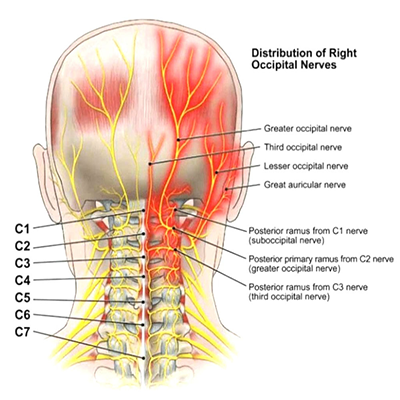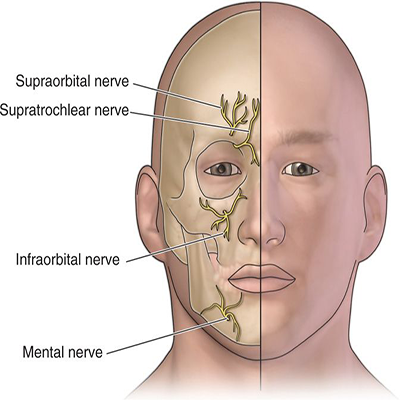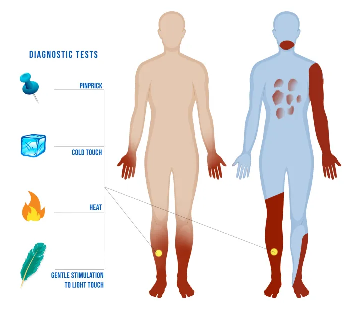Neuralgia is an intense, typically intermittent pain along the course of a nerve, especially in the head or face
If anyone is frequently experiencing severe stabbing or burning pain, then you may have a damaged or irritated nerve and it can occur throughout the body and face. Although neuralgia can occur without the presence of disease, for example when leg compression causes the foot to fall asleep, there are certain types of neuralgia that can be attributed to various diseases.
Types of Neuralgia
Trigeminal Neuralgia
The trigeminal nerve receives sensation from one side of the face. When it becomes damaged or irritated, eating, talking, or the feeling of wind can cause excruciating pain. In fact, this is believed to be one of the most painful conditions and can eventually cause disability. Trigeminal neuralgia can be caused by compression of the trigeminal nerve by blood vessels exiting the brain, tumors, or a tangle of arteries. It can also occur when the nerve becomes damaged from surgery, stroke, or facial trauma. Additionally, Trigeminal neuralgia is also seen in people with multiple sclerosis.
Post-herpetic Neuralgia
This type of neuralgia is characterized by a burning sensation on the skin where a previous herpes rash has formed. The skin in the affected area is also highly sensitive to touch or changes in temperature. Normally, people with shingles develop a painful rash that eventually heals. Once the rash heals, the pain is also supposed to go away. However, if the herpes damages the nerves, then the pain will continue even after the rash has completely healed. Post-herpetic neuralgia is the most common herpes zoster complication and affects about 20% of people diagnosed with herpes.
 Occipital Neuralgia
Occipital Neuralgia
The occipital nerves extend from the spinal cord to the scalp. Occipital neuralgia occurs due to chronic muscle tension, blood vessel inflammation, tumors, or if osteoarthritis compresses one or more nerves in the neck. This causes sudden, severe pain that lasts for seconds or minutes. Although Occipital neuralgia is considered to be a rare type of headache disorder, it varies from traditional headaches and migraines in that the pain is short-lived, intense, piercing, or sharp. Both headaches and migraines are described as throbbing pain that lasts for an extended period of time.
Auriculo-temporal Neuralgia
The auriculo-temporal nerve runs from the side of the head, down along the scalp and ear, then into the jaw bone. Compression or damage of this nerve causes pain to shoot down the ear, side of the face, side of the forehead, and upper side of the face.
 Supraorbital & Supratrochlear Neuralgia
Supraorbital & Supratrochlear Neuralgia
The supra-orbital nerve provides sensation to the upper eyelid, forehead, and scalp. When this nerve is damaged or compressed, it can cause pain above the eyebrows that can also extend into the scalp. Forehead pain, as well as tenderness in the area below the brow bone can also be caused by both forms.
Cause
The basic cause of any type of neuralgia is either damage or compression to a nerve. Each nerve in our body is protected by a coating called, myelin. When the myelin is damaged or wears away from the nerve, the stabbing, severe, shock-like pain of neuralgia results.
Infection
The cause of post-herpetic neuralgia is herpes, an infection caused by herpes zoster virus. The likelihood of having this infection increases with age. Lyme disease, HIV, and syphilis can also cause neuralgia
Multiple Sclerosis
Multiple sclerosis is a disease that is caused by the degeneration of myelin. Among the many symptoms that result from Multiple sclerosis is neuralgia, often in the face.
Pressure on Nerves
The myelin on nerves can get worn away by pressure. The pressure may due to a bone, ligament, blood vessel, or a tumor that is pressing on the nerve. The pressure of a swollen blood vessel is a common cause in trigeminal neuralgia.
 Diabetic Neuropathy
Diabetic Neuropathy
Many people with diabetes will suffer from some type of neuralgia because excess glucose in the bloodstream can cause myelin damage.
Types of Diabetic Neuropathy
Peripheral neuropathy
Peripheral neuropathy is nerve damage that typically affects the feet and legs and sometimes affects the hands and arms.
Autonomic neuropathy
Autonomic neuropathy is damage to nerves that control your internal organs. Autonomic neuropathy can lead to problems with your heart rate and blood pressure, digestive system, bladder, sex organs, sweat glands, eyes, and ability to sense hypoglycemia
Focal neuropathies
Focal neuropathies are conditions in which you typically have damage to single nerves, most often in your hand, head, torso, and leg.
Proximal neuropathy
Proximal neuropathy is a rare and disabling type of nerve damage in your hip, buttock, or thigh. This type of nerve damage typically affects one side of your body and may rarely spread to the other side. Proximal neuropathy often causes severe pain and may lead to significant weight loss.
Less Common Causes: If the cause of neuralgia cannot be blamed on an infection, MS, diabetes, or pressure on the nerves, it may be from one of many less common factors. These include: kidney disease, porphyria (a rare blood disease).Anti-cancer medicines like cisplatin, paclitaxel, or vincristine.
Treatment Options
Medical therapy
Medications prescribed may include over-the-counter pain relievers like aspirin or ibuprofen, antidepressants, anti-seizure medications, topical creams with capsaicin
Nerve Blocks
Nerve blocks like trigeminal nerve block are injections directed at a particular nerve or nerve group that is intended to reduce inflammation and relieve pain
Chemical (Alcohol / Phenol ) Injections
Alcohol or Phenol injections are commonly used for bringing substantial relief in trigeminal neuralgia
Radiofrequency Ablation
RF ablation is commonly used in trigeminal neuralgia to numb the pain-generating structure and reduce the intensity of pain.
Stereotactic radiosurgery
is a fairly new treatment that uses a concentrated beam of radiation to deliberately damage the trigeminal nerve where it enters the brainstem. Stereotactic radiosurgery does not require a general anaesthetic and no cuts or incisions are made.